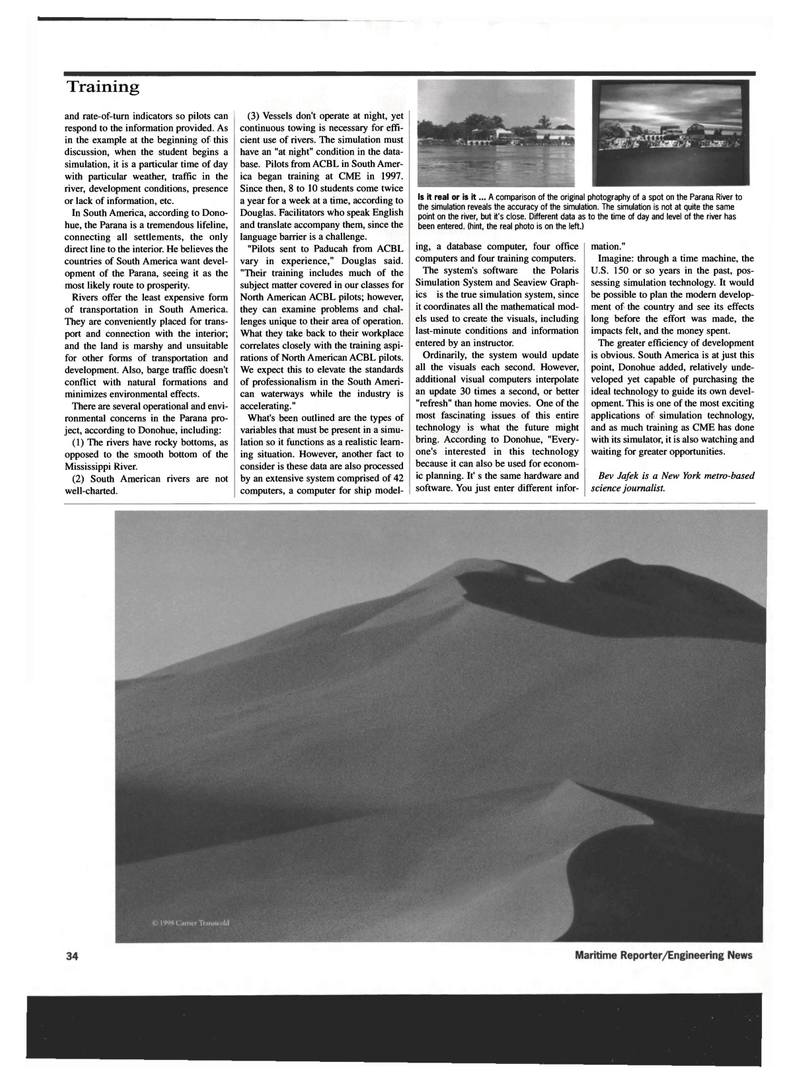
Page 34: of Maritime Reporter Magazine (October 1999)
Read this page in Pdf, Flash or Html5 edition of October 1999 Maritime Reporter Magazine
Training
Is it real or is it... A comparison of the original photography of a spot on the Parana River to the simulation reveals the accuracy of the simulation. The simulation is not at quite the same point on the river, but it's close. Different data as to the time of day and level of the river has been entered, (hint, the real photo is on the left.) and rate-of-turn indicators so pilots can respond to the information provided. As in the example at the beginning of this discussion, when the student begins a simulation, it is a particular time of day with particular weather, traffic in the river, development conditions, presence or lack of information, etc.
In South America, according to Dono- hue, the Parana is a tremendous lifeline, connecting all settlements, the only direct line to the interior. He believes the countries of South America want devel- opment of the Parana, seeing it as the most likely route to prosperity.
Rivers offer the least expensive form of transportation in South America.
They are conveniently placed for trans- port and connection with the interior; and the land is marshy and unsuitable for other forms of transportation and development. Also, barge traffic doesn't conflict with natural formations and minimizes environmental effects.
There are several operational and envi- ronmental concerns in the Parana pro- ject, according to Donohue, including: (1) The rivers have rocky bottoms, as opposed to the smooth bottom of the
Mississippi River. (2) South American rivers are not well-charted. (3) Vessels don't operate at night, yet continuous towing is necessary for effi- cient use of rivers. The simulation must have an "at night" condition in the data- base. Pilots from ACBL in South Amer- ica began training at CME in 1997.
Since then, 8 to 10 students come twice a year for a week at a time, according to
Douglas. Facilitators who speak English and translate accompany them, since the language barrier is a challenge. "Pilots sent to Paducah from ACBL vary in experience," Douglas said. "Their training includes much of the subject matter covered in our classes for
North American ACBL pilots; however, they can examine problems and chal- lenges unique to their area of operation.
What they take back to their workplace correlates closely with the training aspi- rations of North American ACBL pilots.
We expect this to elevate the standards of professionalism in the South Ameri- can waterways while the industry is accelerating."
What's been outlined are the types of variables that must be present in a simu- lation so it functions as a realistic learn- ing situation. However, another fact to consider is these data are also processed by an extensive system comprised of 42 computers, a computer for ship model- ing, a database computer, four office computers and four training computers.
The system's software the Polaris
Simulation System and Seaview Graph- ics is the true simulation system, since it coordinates all the mathematical mod- els used to create the visuals, including last-minute conditions and information entered by an instructor.
Ordinarily, the system would update all the visuals each second. However, additional visual computers interpolate an update 30 times a second, or better "refresh" than home movies. One of the most fascinating issues of this entire technology is what the future might bring. According to Donohue, "Every- one's interested in this technology because it can also be used for econom- ic planning. It's the same hardware and software. You just enter different infor- mation."
Imagine: through a time machine, the
U.S. 150 or so years in the past, pos- sessing simulation technology. It would be possible to plan the modern develop- ment of the country and see its effects long before the effort was made, the impacts felt, and the money spent.
The greater efficiency of development is obvious. South America is at just this point, Donohue added, relatively unde- veloped yet capable of purchasing the ideal technology to guide its own devel- opment. This is one of the most exciting applications of simulation technology, and as much training as CME has done with its simulator, it is also watching and waiting for greater opportunities.
Bev Jafek is a New York metro-based science journalist.

 33
33

 35
35
